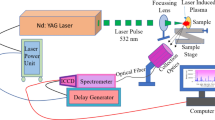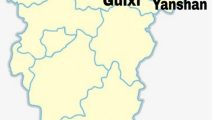Abstract
The primary aim of this work was to study the diseased and healthy rice plant samples at the elemental and molecular level to get the proper understanding of the causes and the chemical changes occurred in the healthy rice grains with the infestation due to false smut disease. We have used microscopic and isolation methods to detect and identify the presence of the species of pathogen involved in the diseased rice plant samples. Elemental analyses of rice grains were carried out using laser-induced breakdown spectroscopy (LIBS) and wavelength dispersive X-ray fluorescence (WDXRF) spectrometry. This revealed the mineral changes appeared in diseased rice plant samples due to the invasion of pathogens. The results from LIBS and WDXRF showed that the mineral elements such as calcium (Ca), magnesium (Mg), silicon (Si), copper (Cu) and iron (Fe) decreased in diseased rice grains than those of healthy rice grains whereas some elements showed their variable behavior in diseased rice grains than those of healthy grains. The results obtained by LIBS is in close agreement with the results obtained by WDXRF. We have employed Fourier-transform infrared (FTIR) spectroscopy to study the molecular changes appeared in the active bio compounds of the rice grains due to the infection caused by false smut. The present spectroscopic studies would provide the proper understanding of the rice false smut disease and also help in developing the proper treatment strategies to prevent the further yield loss caused by the rice false smut disease.







Similar content being viewed by others
References
A.K. Singh, S.P. Singh, S.K.S. Rajpoot, Evaluation of ipm modules against major rice insect pests of rice in st. Kabir Nagar district of UP. Int. J. Curr. Microbiol. App. Sci. 7, 4400–4404 (2018)
Geography and You. Cultivating rice crop in India-A production update. (Geography and You, New Delhi, India, 2018). Report May 2018. https://www.geographyandyou.com/cultivating-rice-crop/. Assessed 21 Dec 2019
Q. Jiehua, M. Shuai, D. Yizhen, H. Shiwen, K. Yanjun, Ustilaginoidea virens: a fungus infects rice flower and threats worldwide rice production. Rice Sci 26, 199–206 (2019)
A.K. Singh, D.J. Pophaly, An unusual rice false smut epidemic reported in Raigarh District, Chhattisgarh. Int. Rice Res. Notes 35, 1–3 (2010)
M.C. Rush, A.K.M. Shahjahan, J.P. Jones, D.E. Groth, Outbreak of false smut of rice in Louisiana. Plant Dis. 84, 100 (2000)
M.M.M. Atia, Rice false smut (Ustilaginoidea virens) in Egypt. J. Plant Dis. Protect. 111, 71–82 (2004)
D. Ladhalakshmi, G.S. Laha, R. Singh, A. Karthikeyan, S.K. Mangrauthia, R.M. Sundaram, B.C. Viraktamath, Isolation and characterization of Ustilaginoidea virens and survey of false smut disease of rice in India. Phytoparasitica 40, 171–176 (2012)
D.S. Dodan, R. Singh, False smut of rice: present status. Agric. Rev. 17, 227–240 (1996)
A. Biswas, False smut disease of rice: a review. Env. Ecol. 19, 67–83 (2001)
E. Tanaka, T. Ashizawa, R. Sonoda, C. Tanaka, Villosiclava virens gen. nov., comb. Nov., teleomorph of Ustilaginoidea virens, the casual agent of rice false smut. Mycotoxin 106, 491–501 (2008)
H.S. Chib, M.L. Tikoo, C.S. Kalha, B.R. Gupta, S.K. Singh, P.K. Raina, Effect of false smut on yield of rice. Indian J. Mycol. Pl. Path. 22, 278–280 (1992)
Z. Jiang, Z. Jiang, Z. Jiang, G. Zhang, Effect of false smut balls on yield of rice northern rice. Northern Rice 39, 53–54 (2009)
L.E. Datnoff, W. Elmer, D.M. Huber, Mineral Nutrition & Plant Disease (APS Stress, St. Paul, 2007)
D. Bhaduri, R. Rakshit, K. Chakraborty, Primary and secondary nutrients-a boon to defense system against plant diseases. Int. J. Bio-res. Stress Manage 5, 461–466 (2014)
N. Gupta, S. Debnath, S. Sharma, P. Sharma, J. Purohit, Agriculturally Important Microbes for Sustainable Agriculture (Springer, New Delhi, 2017), pp. 217–261
S. Prakash, J.P. Verma, in potassium, solubilizing microorganisms for sustainable agriculture: global perspective of potash for fertilizer production (Springer, New Delhi, 2016), pp. 327–331
D.R. Grahm, M.J. Webb, Micronutrients in Agriculture: Micronutrients and Disease Resistance & Tolerance in Plants (Soil Science Society of America, Madison, 1991), pp. 329–370
S. Szeghalmi, K.M. Kaminskyj, A synchrotron FTIR microspectroscopy investigation of fungal hyphae grown under optimal and stressed conditions. Anal. Bioanal. Chem. 387, 1779–1789 (2007)
N. Sharma, Y. Khajuria, J. Sharma, D.K. Tripathi, D.K. Chauhan, V.K. Singh, V. Kumar, V.K. Singh, Microscopic, elemental and molecular spectroscopic investigations of root knot nematode infested okra plant roots. Vacuum 158, 126–135 (2018)
J.E. Sansonettia, W.C. Martin, Handbook of basic atomic spectroscopic data. J. Phys. Chem. Ref. Data 34, 1559–2259 (2005)
A.W. Miziolek, V. Palleschi, I. Schechter, Laser-Induced Breakdown Spectroscopy (LIBS): Fundamentals and Applications (Cambridge University Press, New York, 2006)
H.H. Cho, Y.J. Kim, Y.S. Jo, K. Kitagawa, N. Arai, Y. Lee, Application of laser-induced breakdown spectrometry for direct determination of trace elements in starch-based flours. J. Anal. At. Spectrom. 16, 622–627 (2001)
C.J. Park, J.K. Suh, Determination of trace elements in rice flour by isotope dilution inductively coupled plasma mass spectrometry. J. Anal. At. Spectrom. 12, 573–577 (1997)
M. Dow, A. Molinaro, R.M. Cooper, M.A. Newman, Microbial Glycobiology: Structures, Relevance and Applications: Microbial Glycosylated Components in Plant Disease: Chapter 40 (Academic Press, Cambridge, 2010), pp. 803–820
D.M. Huber, Plant Disease; An Advanced Treatise, Vol-V How Plants Defend Themselves: The Role of Mineral Nutrition in Defense (Academic Press, New York, 1980), pp. 381–406
E. Sieverding, G.A. Silva, R. Berndt, F. Oehl, Rhizoglomus, a new genus of the Glomeraceae. Mycotaxon 129, 373–386 (2014)
T.L. Karasov, E. Chae, J.J. Herman, J. Bergelson, Mechanisms to mitigate the trade-off between growth and defense. Plant Cell 29, 666–680 (2017)
V.K. Singh, A. Devi, S. Pathania, V. Kumar, D.K. Tripathi, S. Sharma, D.K. Chauhan, V.K. Singh, V. Zorba, Spectroscopic investigation of wheat grains (Triticum aestivum) infected by wheat seed gall nematodes (Anguina tritici). Biocatal. Agric. Biotechnol. 9, 58–66 (2017)
C. Dordas, Role of nutrients in controlling plant diseases in sustainable agriculture. A review. Agron. Sustain. Dev. 28, 33–46 (2008)
D.A. Barber, R.B. Lee, the effect of micro-organisms in the absorption of Mn by plants. New Phytol. 76, 69–80 (1974)
D.F. Bateman, An induced mechanism of tissue resistance to polygalacturonase in Rhizoctonia-infected hypocotyls of bean. Phytopathology 54, 438–445 (1964)
M.C. Meyer, E. Hirose, Soja Louca II: um problema de causa desconhecida. Rev. Plantio Direto. 118, 1–4 (2010)
A.C. Ranulfi, G.S. Senesi, J.B. Caetano, M.C. Meyer, A.B. Magalhães, P.R. Villas-Boas, D.M.B.P. Milori, Nutritional characterization of healthy and Aphelenchoides besseyi infected soybean leaves by laser-induced breakdown spectroscopy (LIBS). Microchem. J. 141, 118–126 (2018)
E. Takahashi, J.F. Ma, Y. Miyake, The possibility of silicon as an essential element for higher plants. J. Agric. Food Chem. 2, 99–102 (1990)
H.A. Currie, C.C. Perry, Silica in plants: biological, biochemical and chemical studies: role of silica in stress relief. Ann. Bot. 100, 1383–1389 (2007)
K.P. Fukrei, in M. Sc. Thesis: Path analysis of yield component traits in upland rice and allele mining for aluminium toxicity tolerance (Central Agricultural University, Imphal, India, 2011), pp. 102.
A.K. Shankera, C. Cervantesb, H.L. Taverac, S. Avudainayagam, Chromium toxicity in plants. Environ. Int. 31, 739–753 (2005)
L.D. Fuente, J.K. Parker, J.E. Oliver, S. Granger, P.M. Brannen, E. Santen, P.A. Cobine, The bacterial pathogen Xylella fastidiosa affects the leaf ionome of plant hosts during infection. PLoS ONE 2013, 8 (2013)
Acknowledgements
Financial support from DST, Govt of India to Ms. Neha Sharma, SRF and Inspire Fellowship (No. DST/INSPIRE Fellowship/2016/IF160893) is duly acknowledged. Authors are also grateful to CIL and SAIF, Punjab University, India to provide experimental facilities of FTIR and WDXRF spectroscopy. Mr. Tejbir Singh (SAIF, Punjab University) is gratefully acknowledged for providing the details on the technical aspects of WDXRF spectrometry to discuss the results throughout the manuscript.
Author information
Authors and Affiliations
Contributions
The two authors K and PKR contributed equally to the final version of the paper.
Corresponding author
Ethics declarations
Conflicts of interest
The authors Neha Sharma, Kamni, Virendra K. Singh, Sandeep Kumar, Yonghoon Lee, Piyush K. Rai, and Vivek K. Singh declare that they have no conflict of interest.
Ethical approval
This article does not contain any studies with human participants or animals performed by any of the authors.
Additional information
Publisher's Note
Springer Nature remains neutral with regard to jurisdictional claims in published maps and institutional affiliations.
Rights and permissions
About this article
Cite this article
Sharma, N., Kamni, Singh, V.K. et al. Investigation of molecular and elemental changes in rice grains infected by false smut disease using FTIR, LIBS and WDXRF spectroscopic techniques. Appl. Phys. B 126, 122 (2020). https://doi.org/10.1007/s00340-020-07475-8
Received:
Accepted:
Published:
DOI: https://doi.org/10.1007/s00340-020-07475-8




